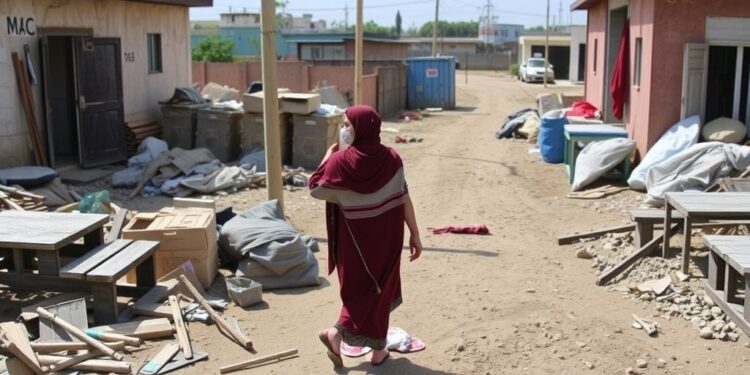Internal displacement has emerged as a pivotal mechanism in the Syrian conflict, shaping the country’s political and social spheres in profound ways. Recent research conducted by Samer Bakkour and Rama Sahtout from the University of Exeter uncovers how the Assad regime systematically utilized internal displacement not only as a consequence of war but as a deliberate military-political strategy. This strategy aimed to restructure the demographics of certain regions, effectively altering the political landscape and embedding displacement as a long-term tool of governance, with extensive implications for post-war recovery.
The research reveals that the tactics employed by the regime go beyond mere military necessities. Instead, they demonstrate a calculated approach to displace populations from crucial urban areas where opposition forces had established strongholds. The study details that the imposition of violence, characterized by indiscriminate shelling and aerial bombardments, was not simply a byproduct of war, but a critical component designed to manipulate civilian demographics. By forcibly moving populations, the regime aimed to create a clear demarcation between those aligned with the state and those perceived as enemies, a strategy that complicates both immediate military objectives and future political reconciliation.
A notable finding of the study is that internal displacement served the dual purpose of uprooting opposition elements while simultaneously allowing the regime to consolidate its control over the remaining population. The forced migration of civilians was accompanied by a narrative that suggested those who remained in targeted areas were inherently disloyal or supportive of the opposition. This shift enabled the regime to justify its military actions and further its agenda to depopulate and subsequently repopulate urban spaces with individuals deemed more compliant.
Dr. Sahtout, one of the primary researchers, emphasizes the implications of this strategy. He notes that the displacement allowed the regime to effectively “cleanse” areas of perceived opposition and, in turn, manipulate local demographics to solidify the regime’s power. The descriptive analysis presented in the study indicates that this was not an incidental fallout of the conflict but a meticulously planned and executed strategy. The findings advocate for a reconsideration of how displacement is addressed in both academic and policy discussions, urging stakeholders to recognize it as a fundamental aspect of the conflict, rather than merely a humanitarian crisis necessitating intervention.
In framing internal displacement as a political necessity, the study urges a recalibration of the responses to such crises. It calls for policymakers to engage with the underlying strategic motivations behind displacement and to move beyond protection-oriented approaches. The authors argue that addressing the grievances associated with displacement is essential for any meaningful dialogue about post-conflict reconstruction and reconciliation in Syria.
The consequences of this systematic displacement strategy extend well beyond the immediate conflict. By integrating displacement into its military strategy, the Assad regime has laid the groundwork for long-lasting changes in Syrian society that can impede recovery efforts. Such transformation is pivotal for understanding the protracted nature of the Syrian conflict and the ongoing challenges that arise from the disruption of social fabric, as long-standing community ties and networks are dismantled through forced migration.
Moreover, the research highlights the importance of adaptive strategies by displaced populations finding refuge in regions controlled by the regime. Many who managed to navigate state borders were allowed back in under the premise of demonstrating their loyalty to the regime. This dynamic creates a complex environment where survival is contingent upon perceived political allegiance. Consequently, those displaced by the violence face not only the consequences of loss but also the challenge of navigating a landscape marked by suspicion and differentiation based on loyalty to the state.
Furthermore, this study contributes to a broader understanding of the function of displacement in modern warfare and political strategy. It opens up critical conversations around how similar strategies might be employed in other contexts, where populations are forcibly moved to reshape socio-political landscapes. The implications of such strategies extend beyond individual conflicts, shedding light on how international norms surrounding warfare and human rights are increasingly challenged by state actors seeking to achieve strategic ends through displacement.
Confronting these realities requires a nuanced approach that takes into account the layers of violence, the complexity of political affiliations, and the historical contexts of affected communities. This in-depth analysis of internal displacement in Syria highlights the necessity for interdisciplinary discourse that blends political science, sociology, and migration studies to fully grasp the ramifications of such strategies.
In conclusion, the research conducted by Bakkour and Sahtout insists on a critical reevaluation of internal displacement. By framing it as a strategic military-political tool, the findings emphasize the need for a deeper understanding amongst policymakers to ensure that future strategies address not just the immediate needs of the displaced but also the political realities that shape their experiences. As the conflict in Syria continues to evolve, the lessons drawn from this study resonate on a global scale, urging a reconsideration of how conflicts are understood and managed in an increasingly complex geopolitical landscape.
Subject of Research: Internal displacement in Syria as a military-political strategy
Article Title: Uprooting, removing and relocating populations: The role and significance of internal displacement in the syrian regime’s integrated military–political war strategy
News Publication Date: 2-Jan-2025
Web References: DOI: 10.1186/s40878-024-00403-1
References: Available in the study.
Image Credits: Not specified.
Keywords: Internal displacement, Syria, political strategy, military tactics, post-conflict reconciliation.




